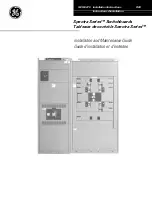
28
Types SDV-R and SDV-R-AR distribution circuit breakers |
Instruction manual
Construction
The essential parts of the operating
mechanism are shown in Figure 12: Stored-
energy operating mechanism (circuit
breaker shown in OPEN position). The
control and sequence of operation of the
mechanism is described in Figure 17:
Stored-energy operating mechanism shown
in OPEN position on page 30.
Motor-operating mechanism
Figure 12: Stored-energy operating
mechanism (circuit breaker shown in OPEN
position) on page 26. The spring-charging
motor (88.0) is bolted to the charging
mechanism gear box (63.0) installed in the
operator housing. Neither the charging
mechanism nor the motor require any
maintenance.
Mode of operation
The operating mechanism is of the stored-
energy, trip-free type. The charging of the
closing spring is not automatically followed
by the contacts changing position, and
tripping function prevails over the closing
function.
When the stored-energy mechanism has
been charged, the mechanism is ready for a
circuit breaker closing operation (ground
switch opening operation) at any time. The
mechanical energy for carrying out an
“Open-Close-Open” sequence for auto-
reclosing duty is stored in the closing and
opening springs.
Charging
The details of the closing spring charging
mechanism are shown in Figure 17: Stored-
energy operating mechanism shown in
OPEN position on page 30. The charging
shaft is supported in the charging
mechanism gear box (63.0) but is not
coupled mechanically with the charging
mechanism. Fitted to it are the crank (70.0)
at one end, and the cam (59.0), together
with lever (60.0), at the other.
When the charging mechanism is actuated
by hand with a hand crank (refer to Figure
15: Use of manual spring-operation crank)
or by a motor (74.0), the charging flange
(cam) (59.0) turns until the driver (57.0)
locates itself in the cutaway part of the
charging flange (cam) (59.0), thus causing
the charging shaft to follow. The crank
(70.0) charges the closing spring (75.0).
When the closing spring has been fully
charged, the crank actuates the linkage
(73.0) via the control lever (64.0) for the
closing spring CHARGED indicator (54.0)
and actuates the limit switches (77.0) for
interrupting the motor supply. At the same
time, the lever (60.0) at the other end of the
charging shaft is securely locked by the
close latch pawl (82.0). When the closing
spring is being charged, the charging flange
(cam) (59.0) follows along, and it is brought
into position for closing when the closing
spring is fully charged.
Figure 15: Use of manual spring-operation crank
Item
Description
90.0
Hand crank
51.0
Manual spring-charging port
52.0
Close pushbutton
53.0
Open pushbutton
54.0
CHARGED/DISCHARGED indicator
Item
Description
51.0
Manual spring-charging port
50.6
Over-running coupling
Figure 14: Manual hand crank
51.0
50.6
90.0
51.0
53.0
52.0
54.0














































